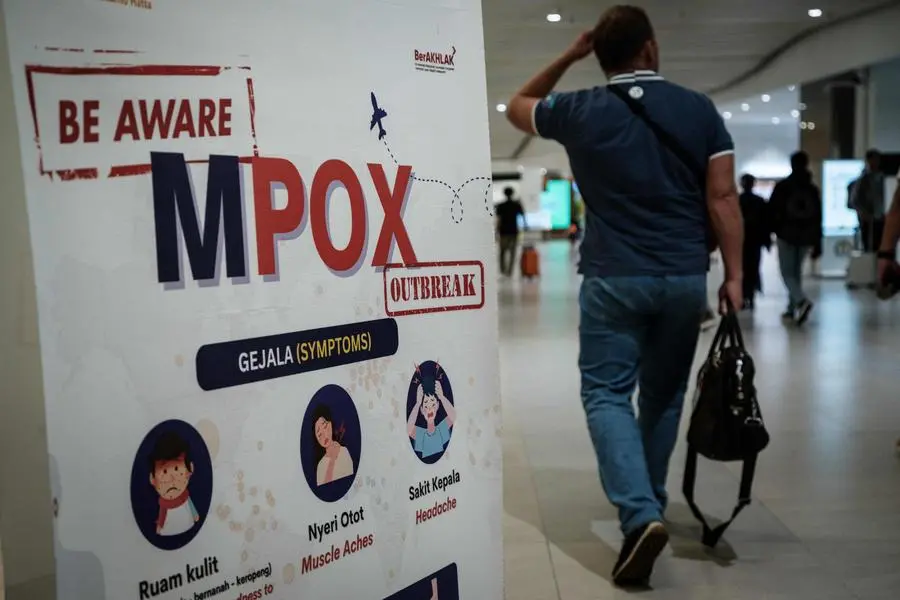PHOTO
A passenger walks past a banner informing about Monkeypox (MPOX) at Soekarno-Hatta International Airport in Tangerang on August 26, 2024. (Photo by YASUYOSHI CHIBA / AFP) Image used for illustrating purpose.
Kenya has recorded its first mpox death. Public Health Principal Secretary Mary Muthoni has said that the number of confirmed cases in the country now stands at 13."Nakuru has two cases, Kajiado (2), Bungoma (2), Taita Taveta (1), Busia (1), Nairobi (1), Mombasa (1), Makueni (1), Kericho (1) and Kilifi (1)," she disclosed on Monday adding that as of October 14, 2024, the National Public Health Laboratory had received 238 samples, of which 13 tested positive while 225 tested negative.
According to the Ministry of Health's Mpox Situation Update Report number 57 for October 14, 2024, no new cases of mpox have been confirmed in the last 24 hours.
The report says sixty-eight contacts have been listed, 61 have been followed for 21 days, three have tested positive for mpox, and four are being followed. 21,972 travellers have been screened at points of entry (POE) in the last 24 hours, while a cumulative 1,332,420 travellers have been screened at 26 POEs," the document sent to Nation highlights.
PS Muthoni added that 366,838 people have been sensitised about mpox at the POE so far."Risk communication and community engagement messages have been approved for dissemination to combat stigma and promote infection prevention. The cumulative number of people sensitised on mpox at the POE is 366,838, plans are underway to deploy rapid response teams for comprehensive investigation and contact tracing," she told Nation, adding that the Kenya Red Cross has committed to support the bulk SMS for mpox messaging."Symptomatic management of confirmed cases is ongoing. Training materials have been developed to assist those affected as well as mental health and psychosocial support for those affected," the PS said.
There are two main strains, or clades, of mpox. Until 2022, neither was commonly reported outside of a handful of African countries.
But that changed when Clade IIb, a virus that causes a "milder" version of mpox, spread from Nigeria to the global North, sparking international concern and a large-scale effort to produce vaccines and immunise newly at-risk populations.
Although interventions eventually brought the international Clade IIb outbreak under control, mpox continued to circulate, including Clade I, the more virulent strain endemic to the Democratic Republic of the Congo.
Clade IAfrica CDC reports that Clade I has been reported in Kenya, Burundi, CAR, Congo, DRC, Rwanda and Uganda. Clade II has been reported in the Côte d'Ivoire, Liberia, Nigeria, and South Africa. Clade I and Clade II have been reported in Cameroon, while the Clade in Gabon has not yet been identified.
As a result, the WHO declared an emergency for the more lethal clade I for two reasons: the increasing spread of clade I cases in Africa, even in areas and countries where it had never been detected before, and the emergence of a new subtype of the clade called Ib.
Clade Ib has genotypic and epidemiologic characteristics that favour human-to-human transmission.
In August, Kenya's Director-General for Health Dr Patrick Amoth reassured the public that healthcare facilities are fully prepared to diagnose and manage the disease and that there is no need to panic.“To reduce stigma and prevent the spread of the disease, we shall continue to share important information through our official social media accounts, the press and other public health forums countrywide, “he highlighted while adding that they remain dedicated to safeguarding the health and well-being of all citizens. “Our rapid response teams (RRTs) are in place to support affected counties with thorough investigations and appropriate response measures to any new cases.
The Public Health Emergency Operation Centres have been activated nationwide to enhance coordination of response efforts, and Incident Management Teams have been established to oversee coordination activities at both national and county levels,” Dr Amoth said while urging county governments to work closely with the health ministry and other agencies as well as other partners to ensure all necessary measures are in place to protect the public.
Dr Amoth did not however disclose the kind of tests the government is performing on suspected mpox patients.
In the same month, the Director General at Africa Centers for Disease and Control Prevention (Africa CDC) Dr Jean Kaseya cautioned African governments including Kenya against solely relying on laboratory test results for diagnosing mpox.
In an official letter sent to Nation Referenced: AU/CDC/ODG/LT/2996.24 and dated 23rd August 2024, Dr Kaseya highlighted that they are now very much concerned about false negative test results.“Some of you are reaching out to us, especially in the context where the lab test is negative for mpox. To better advise African Health Ministers, the Africa CDC consulted not only the continent’s best epidemiologist and lab experts but also international experts and appropriate bodies like US CDC, China CDC, Europe CDC and the World Health Organisation (WHO).“The conclusion is that relying solely on laboratory test results for diagnosing mpox is not advisable, while important, lab tests should be interpreted in conjunction with clinical and epidemiological data.
False negatives are possible, and a negative test does not entirely rule out mpox, especially if there is strong clinical suspicion, and for all mpox cases, countries have to perform HIV and STI tests,” Dr Kaseya explained.
Close contactAccording to the National Library of Medicine, the incubation period of mpox has historically been reported to range from five to 21 days and may vary depending on the type of exposure and transmission route.
The WHO notes that mpox spreads from person to person primarily through close contact."Close contact includes skin-to-skin contact (such as touching or sex) and mouth-to-mouth or mouth-to-skin contact (such as kissing), and it can also include being face-to-face with someone who has mpox (such as talking or breathing close to one another, which can generate infectious respiratory particles). People with multiple sexual partners are at a higher risk of getting mpox," the global health authority points out."People can also get mpox from contaminated objects such as clothing or linen, from needlestick injuries in health care settings, or in community settings such as tattoo parlours."
© Copyright 2022 Nation Media Group. All Rights Reserved. Provided by SyndiGate Media Inc. (Syndigate.info).




















